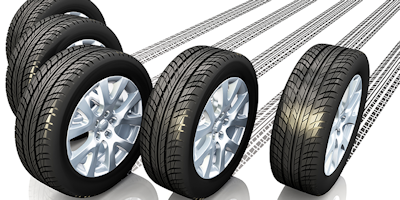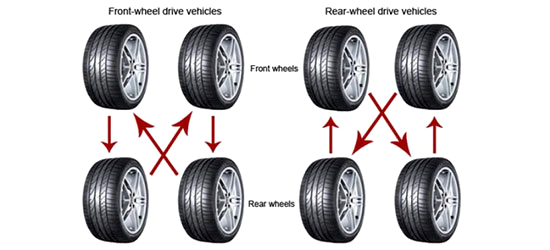

Mobile users:
For best results, view in Landscape mode.

The maintenance of the tires can be the difference
between loosing control and safe driving.
It is important to check your tires regularly.
The only way to determine proper tire pressure is to use an
accurate gauge.
Make sure you check air while the tires are cool
(when you haven't driven).
Even a short drive can make your tires too hot for accurate pressure
readings.
When the tires warm up, the air pressure rises slightly, and can give
a false reading as to the actual tire pressure in the tires.
Under inflated tires wastes fuel and over
inflated tires can be hazardous.
Your tires need extra attention during the winter.
Colder temperatures will cause tire pressure to drop about
1 psi for every 10°F drop in air temperature.
Check tire pressure regularly, especially after a sharp drop in
temperature.
Avoid excessive tire spinning when your car gets stuck in snow, ice,
or mud.
The force generated by a spinning tire/wheel assembly may cause
sudden tire explosion, resulting damage to your car and/or serious
personal injury to you or a bystander.
Use the inflation pressure recommended by the vehicle’s manufacturer,
not the maximum pressure embossed on the tire’s sidewall.
Check the sidewalls for cuts, cracks and bulges.
Don't worry about fine surface cracks.
Check for objects that may have punctured the tire, such as nails,
screws, glass, or stones.
Before you touch the tire, make sure there are no pieces of steel
belting or metal embedded in the rubber which could result in a
cut or splinter.
Also make sure the vehicle is turned off and the parking brake
is engaged.
Also regularly inspect your tires for irregular wear and sidewall
bubbles.
Irregular wear is often caused by a worn or misaligned suspension,
or improper inflation.
Sidewall bubbles are caused by a break in the sidewall and could
cause a blow-out.

Front tires are affected by cornering, wearing out at the edge
more quickly than those in the back, while tires that are
mounted to the drive wheels will be subjected to additional wear
under acceleration.
Get your tires rotated and balanced, and your alignment
checked.
Check with your mechanic about how often you should
do this, so your tires wear evenly and your car drives smoothly.
Your tires last much longer by getting them rotated and
balanced.
A tire technician will place your tires and wheels on a machine
that senses the weight distribution and allows the placement
of lead weights on the rim to achieve an even dispersal.
This reduces tire vibration and improves your tires’ ride quality.
Your alignment is just as important.
Do the penny test:
To tell if your tread is worn out is to insert the edge of a penny
into a groove, hold the penny so the top of Lincoln’s head is
pointing toward the tire's surface.
If the top of Lincoln’s head is still visible,
the tread is too shallow and it’s time for
new tires.
Tire tread that is worn down to 2/32 of an inch are not safe
and should be replaced.
Before you replace your tires, always check your owner's manual
and follow the vehicle manufacturer's replacement tire
recommendations.
If you select tires that are different from the original equipment
size, see a qualified tire technician in order to make certain that
proper clearance, load-carrying capacity, and inflation pressure
are selected.
To maintain tire safety, purchase new tires that are the same size
as your car's original tires or another size recommended by the
vehicle manufacturer.
Remember to check the air pressure in your spare tire every month.
If your spare is underinflated, it may shred on the way home or to
the shop.
Also check for small cracks in the sidewall called 'dry rotting'.
Dry rotting is not as common as underinflation.
Like most other things, tires also have a shelf life.
When a tire ages, it loses the protective resin which keeps
the rubber from oxidizing and drying out.
As those oils evaporate, the tire
becomes brittle, and starts developing
cracks and begins to break apart.
